 | | | Switch to: Europe, USA, New Zealand, Antarctica Credit: NOAA/Ovation  Planetary K-index Planetary K-index
Now: Kp= 3.00 quiet
24-hr max: Kp= 3.33 quiet
explanation | more data
Interplanetary Mag. Field
Btotal: 5.37 nT
Bz: 0.08 nT north
more data: ACE, DSCOVR
Updated: Today at 1146 UT  Coronal Holes: 01 Apr 23 Coronal Holes: 01 Apr 23 
There are no large coronal holes on the Earthside of the sun.Credit: SDO/AIA  Noctilucent Clouds Noctilucent Clouds
Bad news: NASA's AIM spacecraft, which monitors noctilucent clouds, may be dead due to problems with an onboard battery. Mission controllers have not yet given up all hope, so stay tuned. Switch view:Ross Ice Shelf, Antarctic Peninsula, East Antarctica, Polar Updated Apr01  SPACE WEATHER
NOAA Forecasts | | Updated at: 2023 Apr 01 2200 UTC FLARE | 0-24 hr | 24-48 hr | CLASS M | 01 % | 01 % | CLASS X | 01 % | 01 % |  Geomagnetic Storms: Geomagnetic Storms:
Probabilities for significant disturbances in Earth's magnetic field are given for three activity levels: active, minor storm, severe storm Updated at: 2023 Apr 01 2200 UTC Mid-latitudes | 0-24 hr | 24-48 hr | ACTIVE | 30 % | 30 % | MINOR | 10 % | 10 % | SEVERE | 01 % | 01 % | High latitudes | 0-24 hr | 24-48 hr | ACTIVE | 15 % | 15 % | MINOR | 25 % | 25 % | SEVERE | 40 % | 40 % | | | |  | | | | | | | | | | | Never miss another geomagnetic storm. Sign up for Space Weather Alerts and you'll receive a text message when magnetic storms erupt. Aurora tour guides and professional astronomers use this service. You can, too! | | | QUIET WEEKEND: Solar activity is low this weekend as multiple sunspots are in decay and pose no threat for strong solar flares. NOAA forecasters say the chance of M- or X-class flares is no more than 1%. Aurora alerts: SMS Text. AN ELVE OVER ITALY: For a few milliseconds last Monday night, March 27th, an enormous red ring of light appeared in the sky over central Italy. Valter Binotto photographed it from the small town of Possagno in the foothills of the Italian Alps: 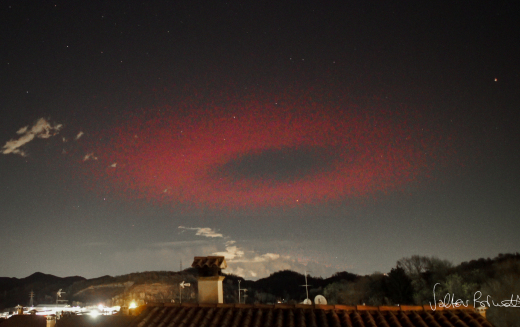
This is an "ELVE"--short for Emissions of Light and Very Low Frequency Perturbations due to Electromagnetic Pulse Sources. It's a rare species of sprite discovered in 1990 by cameras onboard the space shuttle. Binotto may have just taken the best ever picture of one from the ground. "The ELVE was generated by intense lightning in a storm near Ancona about 285 km south of me," says Binotto. One bolt was so strong, it generated an intense electromagnetic pulse (EMP). The red ring marks the spot where the EMP hit Earth's ionosphere. Normal lightning bolts carry 10 to 30 kilo-ampères of current; this bolt was about 10 times stronger than normal. Binotto created a graphic showing the scale of the ELVE: 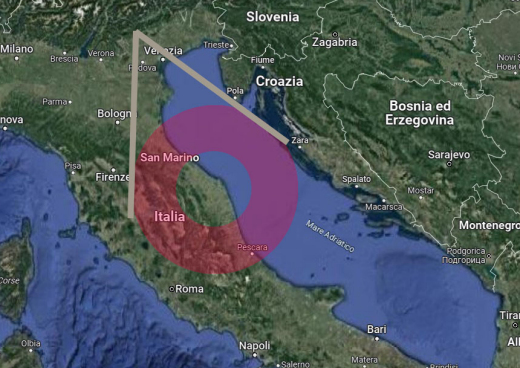
"It was about 100 km high and nearly 360 km wide," says Binotto. "I have been photographing upper atmospheric lightning and transient luminous events (TLEs) since 2019, hundreds of them, and this is one of the biggest structures I have ever seen." ELVE season is just getting started in Europe and North America, where spring and summer thunderstorms will multiply in the months ahead. Photographers should be alert for red rings and many other things above the cloudtops. Look here. Realtime Space Weather Photo Gallery
Free: Spaceweather.com Newsletter OCEAN BLUE CRYSTAL DOLPHIN PENDANT: Are you looking for a far-out gift? Consider the Ocean Blue Crystal Dolphin Pendant. It flew to the stratosphere onboard a cosmic ray research balloon: 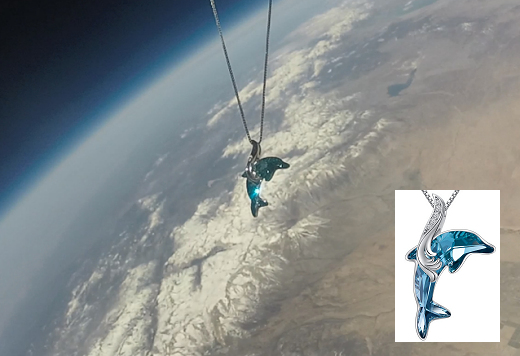
You can have it for $199.95. The students of Earth to Sky Calculus are selling these crystal cetaceans to support their cosmic ray monitoring program. The dolphin is wrapped in a sterling silver wave and suspended from a matching 18-inch chain. It contains no nickel, no lead, no cadmium; the pendant is totally hypoallergenic. Each pendant comes with a greeting card showing the dolphin in flight, and telling the story of its trip to the edge of space and back again. Far Out Gifts: Earth to Sky Store
All sales support hands-on STEM education
Realtime Aurora Photo Gallery
Free: Spaceweather.com Newsletter Every night, a network of NASA all-sky cameras scans the skies above the United States for meteoritic fireballs. Automated software maintained by NASA's Meteoroid Environment Office calculates their orbits, velocity, penetration depth in Earth's atmosphere and many other characteristics. Daily results are presented here on Spaceweather.com. On Apr 01 2023, the network reported 31 fireballs.
(31 sporadics) 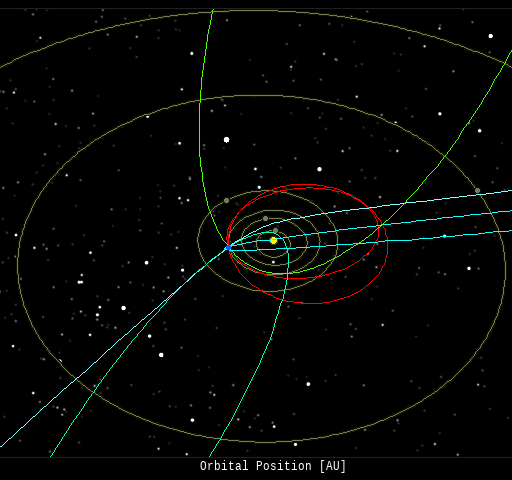 In this diagram of the inner solar system, all of the fireball orbits intersect at a single point--Earth. The orbits are color-coded by velocity, from slow (red) to fast (blue). [Larger image] [movies] Potentially Hazardous Asteroids ( PHAs) are space rocks larger than approximately 100m that can come closer to Earth than 0.05 AU. None of the known PHAs is on a collision course with our planet, although astronomers are finding new ones all the time. On April 1, 2023 there were 2327 potentially hazardous asteroids.
 | Recent & Upcoming Earth-asteroid encounters: | Asteroid | Date(UT) | Miss Distance | Velocity (km/s) | Diameter (m) | | 2023 DX2 | 2023-Mar-27 | 8.5 LD | 9 | 53 | | 2023 FW2 | 2023-Mar-27 | 3.2 LD | 8.7 | 9 | | 2023 FA11 | 2023-Mar-27 | 2.9 LD | 25.5 | 23 | | 2023 FZ2 | 2023-Mar-27 | 3.6 LD | 12.3 | 16 | | 2019 FT | 2023-Mar-27 | 17.1 LD | 28.2 | 93 | | 2023 FU3 | 2023-Mar-28 | 12.1 LD | 7.5 | 18 | | 2014 GC34 | 2023-Mar-29 | 13.7 LD | 25.9 | 85 | | 2023 FP13 | 2023-Mar-29 | 8.7 LD | 13.6 | 34 | | 2022 YK4 | 2023-Mar-29 | 11.9 LD | 2.3 | 25 | | 2023 FR1 | 2023-Mar-30 | 19 LD | 7.9 | 45 | | 2023 EK2 | 2023-Mar-30 | 12.9 LD | 15.4 | 83 | | 2017 SE12 | 2023-Mar-30 | 5.2 LD | 8.4 | 15 | | 2023 FQ4 | 2023-Mar-30 | 4 LD | 7.5 | 11 | | 2023 FH7 | 2023-Mar-30 | 0.4 LD | 8.7 | 6 | | 2016 GH1 | 2023-Mar-30 | 7.7 LD | 5.8 | 11 | | 2023 FO3 | 2023-Mar-31 | 6.6 LD | 10.2 | 17 | | 2023 FF7 | 2023-Apr-01 | 8.7 LD | 10.8 | 15 | | 2023 FZ10 | 2023-Apr-01 | 2.7 LD | 2.8 | 7 | | 2023 FY6 | 2023-Apr-02 | 10 LD | 22.5 | 32 | | 2022 GO3 | 2023-Apr-02 | 17 LD | 11.6 | 15 | | 2021 GN1 | 2023-Apr-02 | 17.7 LD | 14.2 | 18 | | 2023 FU6 | 2023-Apr-03 | 4.9 LD | 10.2 | 14 | | 2023 FS11 | 2023-Apr-03 | 17.3 LD | 11.7 | 26 | | 2023 FA7 | 2023-Apr-04 | 5.9 LD | 24 | 29 | | 2023 FQ7 | 2023-Apr-05 | 15 LD | 8.4 | 21 | | 2023 FZ3 | 2023-Apr-06 | 10.9 LD | 18.8 | 48 | | 2018 FD | 2023-Apr-06 | 16.2 LD | 7.8 | 47 | | 2023 FE4 | 2023-Apr-06 | 9.6 LD | 2.6 | 32 | | 2023 FM | 2023-Apr-06 | 7.8 LD | 15.8 | 164 | | 2020 FL4 | 2023-Apr-06 | 14.1 LD | 5 | 14 | | 2023 FX13 | 2023-Apr-09 | 8.2 LD | 13.3 | 28 | | 2023 FY13 | 2023-Apr-09 | 18.5 LD | 12 | 55 | | 2023 FP5 | 2023-Apr-09 | 10.7 LD | 14.1 | 40 | | 2023 FC4 | 2023-Apr-09 | 19.6 LD | 10.1 | 56 | | 2023 FG5 | 2023-Apr-10 | 9.5 LD | 9.4 | 24 | | 2023 FT1 | 2023-Apr-10 | 19.5 LD | 6.6 | 33 | | 2023 FE5 | 2023-Apr-11 | 11.6 LD | 5.8 | 28 | | 2023 FS10 | 2023-Apr-12 | 3.2 LD | 7.6 | 21 | | 2019 GK21 | 2023-Apr-13 | 15.2 LD | 8.1 | 27 | | 2022 YK9 | 2023-Apr-13 | 19.9 LD | 9.9 | 175 | | 436774 | 2023-Apr-13 | 12.5 LD | 17.6 | 719 | | 2023 FN13 | 2023-Apr-15 | 2.6 LD | 4.5 | 13 | | 2020 BV14 | 2023-Apr-16 | 17.8 LD | 8.2 | 81 | | 2006 HV5 | 2023-Apr-26 | 6.3 LD | 17.4 | 400 | | 2021 JF2 | 2023-Apr-28 | 16.6 LD | 8 | 19 | | 2018 VS6 | 2023-May-01 | 5.2 LD | 11.6 | 14 | | 2011 KY15 | 2023-May-18 | 19.9 LD | 14.3 | 54 | | 2021 JK7 | 2023-May-22 | 16.7 LD | 22.9 | 48 | | 2019 UJ3 | 2023-May-23 | 15.5 LD | 9.8 | 21 | | 2023 CL3 | 2023-May-24 | 18.9 LD | 7.3 | 121 | | 2021 KO2 | 2023-May-29 | 15.8 LD | 13.9 | 9 | Notes: LD means "Lunar Distance." 1 LD = 384,401 km, the distance between Earth and the Moon. 1 LD also equals 0.00256 AU. | | Cosmic Rays in the Atmosphere | SPACE WEATHER BALLOON DATA: Almost once a week, Spaceweather.com and the students of Earth to Sky Calculus fly space weather balloons to the stratosphere over California. These balloons are equipped with sensors that detect secondary cosmic rays, a form of radiation from space that can penetrate all the way down to Earth's surface. Our monitoring program has been underway without interruption for 7 years, resulting in a unique dataset of in situ atmospheric measurements. Latest results (July 2022): Atmospheric radiation is decreasing in 2022. Our latest measurements in July 2022 registered a 6-year low: 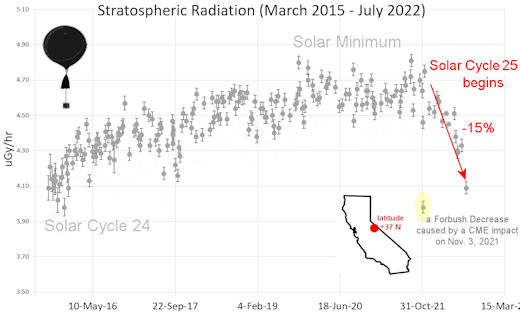
What's going on? Ironically, the radiation drop is caused by increasing solar activity. Solar Cycle 25 has roared to life faster than forecasters expected. The sun's strengthening and increasingly tangled magnetic field repels cosmic rays from deep space. In addition, solar coronal mass ejections (CMEs) sweep aside cosmic rays, causing sharp reductions called "Forbush Decreases." The two effects blend together to bring daily radiation levels down. .Who cares? Cosmic rays are a surprisingly "down to Earth" form of space weather. They can alter the chemistry of the atmosphere, trigger lightning, and penetrate commercial airplanes. According to a study from the Harvard T.H. Chan school of public health, crews of aircraft have higher rates of cancer than the general population. The researchers listed cosmic rays, irregular sleep habits, and chemical contaminants as leading risk factors. A number of controversial studies (#1, #2, #3, #4) go even further, linking cosmic rays with cardiac arrhythmias and sudden cardiac death. Technical notes: The radiation sensors onboard our helium balloons detect X-rays and gamma-rays in the energy range 10 keV to 20 MeV. These energies span the range of medical X-ray machines and airport security scanners. Data points in the graph labeled "Stratospheric Radiation" correspond to the peak of the Regener-Pfotzer maximum, which lies about 67,000 feet above central California. When cosmic rays crash into Earth's atmosphere, they produce a spray of secondary particles that is most intense at the entrance to the stratosphere. Physicists Eric Regener and Georg Pfotzer discovered the maximum using balloons in the 1930s and it is what we are measuring today. | | The official U.S. government space weather bureau | | | The first place to look for information about sundogs, pillars, rainbows and related phenomena. | | | Researchers call it a "Hubble for the sun." SDO is the most advanced solar observatory ever. | | | 3D views of the sun from NASA's Solar and Terrestrial Relations Observatory | | | Realtime and archival images of the Sun from SOHO. | | | information about sunspots based on the latest NOAA/USAF Active Region Summary | | | current counts of failed and deployed Starlink satellites from Jonathan's Space Page | | | Authoritative predictions of space junk and satellite re-entries | | | from the NOAA Space Environment Center | | | fun to read, but should be taken with a grain of salt! Forecasts looking ahead more than a few days are often wrong. | | | from the NOAA Space Environment Center | | | the underlying science of space weather |  | Getting YouTube comments is essential if you want to beat the algorithm! That’s why you need to buy YouTube comments from RealSocialz.com because they offer real USA comments you can customize. |  | BestCSGOGambling is the best site for everything related to CSGO gambling on the web |  | To find reviews of new online casino sites in the UK try The Casino DB where there are hundreds of online casino reviews complete with bonuses and ratings. Alternatively, Online-Casinos.xyz is another massive directory of online casinos listing sites for the UK and Worldwide. Casinos that offer Rupees for bonuses are very generous to Indian players. Find the best online casinos in India at AllCasinos.in Looking for a new online casino? Try Casimpo the new site dedicated to making online casino simple, or check out the new Avenger Slots Casino and Ace Online Casino with over 500 online slots and casino games. |  | When looking for casinos to play online when the weather is bad, you can try casino online trucchi for Italian games. If you are not from Finland you can try the Swedish page Svenska casino online to find suitable games, check out svenskacasinoonline.net. Always check your local laws before playing with real money. |  | Looking for sports betting companies not registered on GamStop? CasinoGap has presented a list of sites not on GamStop available for UK players. Check and bet online! Would you like to bet at sites not using GamStop? Look at a list of NonStopCasino sites for online betting that aren't on GamStop. Top-rated bookmakers ever! | | | These links help Spaceweather.com stay online. Thank you to our supporters! | | | | | | | | |  | |  |   | ©2021 Spaceweather.com. All rights reserved. This site is penned daily by Dr. Tony Phillips. | |

